Fashion loves a ranking. Hence, the large number of lists released each year outlining everything from the industry’s most influential individuals to best companies to work for and schools to attend to brands with the most eco-friendly business models. While this popular information-presenting tool certainly drives traffic and spawns no shortage of third-party press attention for the compiling party (be it an organization, brand, or publication), the resulting conclusions of such rankings tend to be misconstrued, at least when it comes to factors, such as sustainability.
Looking beyond – at least for the time being – the presence of bias in such rankings as a result of undisclosed pay for play elements, which run rampant in at least a handful of the industry’s most highly publicized lists, what about the many sustainability-centric and supply chain-focused rankings that are published each year?
Take KnowTheChain’s annual “Apparel & Footwear Benchmark Findings Report,” for instance. Released late last year, the report ranks 20 of the largest apparel and footwear companies based on their efforts to address forced labor within their supply chains. Scoring well on the list – which is compiled and put forth by the San Francisco-based initiative – are some interesting companies, including H&M, Primark, Gap, adidas, and Zara’s parent company Inditex, among others. Much further down on the list: Kering (parent to Gucci, Yves Saint Laurent, Balenciaga, and Bottega Veneta) and Prada.
Another, more recent report comes by way of the Pesticide Action Network UK, Solidaridad and WWF, and it ranks brands according to their efforts to source sustainable cotton. Topping that list, which was released this week, is C&A Global (a Dutch chain of fashion retailers) and H&M – just to name two. Some of the brands that scored very poorly: Marni and Margiela’s parent company OTB Group, Max Mara, and Giorgio Armani.
Last year, that same list put Burberry, LVMH (parent to Louis Vuitton, Givenchy, Celine, Christian Dior, and Loewe, etc.), Coach, Ralph Lauren and Richemont, the latter of which owns Chloe and Alaia, at the bottom of the list.
What These Reports Do Not Emphasize
How is it, you ask, that some of the industry’s most esteemed high fashion brands – the ones that charge thousands of dollars for their allegedly high-quality garments and accessories – rank so poorly in terms of sustainability and labor practices, when notorious fast fashion giants, like H&M, are given glowing reviews? And do these rankings indicate that high fashion brands necessarily possess supply chains rife with the exact things we have come to associate with fast fashion, namely, human rights abuses and unsustainable manufacturing practices and materials?
While that appears to be the most obvious result to be garnered from these rankings, there is an important element at play that often is not factored into the mass media’s subsequent coverage of these rankings: How the information used to compile these lists is gathered.
As we have noted in the past, these rankings tend to be based entirely on publicly available information. This is problematic for a few reasons. Primarily, given that the information is provided by the companies, themselves, there is a lot of leeway for brands to skew the narrative in their favor. As noted by Elizabeth Winkler, writing for the Washington Post, “Apparel makers lack a common definition of what constitutes ‘sustainability,’ ‘transparency’ or ‘ethical sourcing.’ And in the absence of a uniform standard, each company can assess its ethical record independently and is free to give themselves all the accolades they like.”
That, according to Winkler, “rewards clever marketing and storytelling, not actual monitoring and accountability — and leaves consumers without any way of discerning between brands that meet high labor standards and those that only talk about it.”
Sarah Labowitz, the former co-director of the NYU Stern Center for Business and Human Rights and policy advisor at the U.S. Department of State, echoes the problem of reports that rely entirely – or almost entirely – on this type of methodology.
Speaking of such reports, she recently told Kind Craft: “It was so striking how deferential we all are to the companies themselves in terms of how they’re evaluated. They get to decide what are the salient aspects of their evaluation, as opposed to setting a common standard that all companies in the same sector abide by. If all you’re doing is looking at a company’s self-report on sustainability, then that paradigm rewards companies that are good at communications, right?”
With this in mind, companies that refuse to publicly share manufacturing information tend to be penalized significantly on these rankings, oftentimes without it being made clear to readers exactly why they are ranked poorly.
As for why fast fashion retailers constantly dominate the best rankings, Livia Firth, an eco-fashion activist, and the founder and creative director of sustainability consulting group EcoAge, says, “It’s very, very simple. Fast fashion brands volunteer a whole lot of information about all of their intentions and their pledges, whereas the luxury brands do not want to disclose anything.”
To Provide or Not to Provide
Why do high fashion and luxury brands opt out of providing specifics as to their supply chains, you ask?
Well, that is actually a legal matter, at least in part. Many brands have attempted to keep their suppliers confidential with the intention of warding off competitors. As noted recently by the BBC, “Louis Vuitton, Gucci, Hermes, Chanel, Chloe, Loewe and Carolina Herrera are all reported to use artisans [in the Spanish town of Ubrique] to make things such as handbags, wallets and belts … Yet almost none of these designers is willing to talk about it. Most of the secrecy comes from the fear of someone using the high-end designs to produce cheap copycat products, a costly problem for luxury retailers.”
The BBC’s article, entitled, “The secret supplier to the world’s top designers,” further notes: “Juan Antonio Sanchez, manager at leather goods manufacturer Ranchel, says the big brands often have strict demands. ‘We have to sign a contract of confidentiality, then the factory, the manager and every worker have to sign it.’”
As such, it is not surprising that fast fashion brands tend to produce a lot more information (at least about their top tier suppliers, as distinct from contractors and subcontractors) in comparison to their luxury and high fashion counterparts, which tightly guard their supply chain information in order to protect it as a trade secret. Supplier and manufacturer lists – just like customer lists, sales and distribution methods, advertising strategies, and manufacturing processes – are a textbook type of asset for which businesses rely on trade secret law to protect.
Firth echoes this notion, saying that luxury brands are “all very guarded about where they produce, and who they utilize as suppliers because they are all very unique.” Fast fashion and mass-market brands, on the other hand, tend to have less to protect due to their well-established patterns of frequently switching between suppliers in search of the lowest cost.
There is another aspect to this equation, though. High fashion brands – which are constantly working to brand themselves perfectly in order to maintain their positions as luxury entities in the uppermost echelon of the fashion industry – must be very cognizant of how they “communicate their sustainability goals and achievements to the consumers that care, while preserving the air of mystique” that is traditionally associated with fashion, according to Alden Wicker, the founder of sustainability website, EcoCult.
This is almost certainly why Kering’s individual brands – which are subject to significant sustainability targets – opt to market their wares very tactfully. As the Washington Post’s Robin Givhan noted last year, “With little fanfare, [Gucci’s] nearly $4 billion business has been making changes. The handbags — namely the trendy $2,400 flower-bedecked Dionysus shoulder bags stitched from the signature ‘GG’ Supreme canvas print — now use polyurethane in their design rather than PVC … But the marketing doesn’t highlight the switch; only the vaguest reference on the Gucci website notes that it is produced using an ‘earth-conscious process.’”
Givhan continued: “Gucci’s reluctance to make that shift evident — let alone exciting or sexy for its consumers — highlights the unsettled relationship between the luxury business and eco-fashion,” the latter of which was for many, many years viewed as anything but fashion-forward. It also likely explains why some high fashion brands have been – at least until very recently, for instance, in the case of LVMH – keeping their efforts under wraps.
What’s in a Ranking?
As for whether you buy into the ranking hype or not, at the end of the day, “There is a huge difference between most luxury brands’ manufacturing and fast fashion brands’ manufacturing,” according to Firth. “Due to the nature of luxury goods, most luxury brands have long term relationships with their suppliers and once they have found a factory that can produce, say, that embellishment or that silk at the level that they need, they keep that supplier forever.”
On the other hand, she says, “Fast fashion retailers tend to jump from one factory to another – in fact, from one country to another, in pursuit of the finding the one with the cheapest production cost to produce a huge volume, now.”
That is yet another element that is not taken into account in such rankings, per Firth. The vast differences in the way mass market and upmarket brands’ products are make. “The systems are completely different,” she says.











